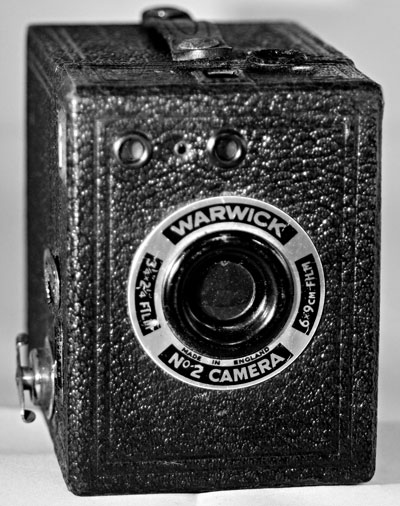Warwick No.2
Specification

| Manufacturer | : | Warwick |
|---|---|---|
| Produced | : | 1935 |
| Classification | : | Medium Format |
| Body Type | : | Box |
| Construction | : | Cardboard/wood/metal |
| Film Type | : | 120 |
| Film Width | : | 62mm |
| Image Size | : | 2¼ x 3¼ in |
| No. of Images | : | 8 |
| Lens Type | : | Meniscus |
| Focus Type | : | Fixed |
| Focal Length | : | 95mm |
| Focus Range | : | 10ft to inf |
| Aperture Type | : | Fixed |
| Aperture | : | f/11 |
| Shutter Type | : | Rotary |
| Shutter Speeds | : | T, I*(1/40 sec) |
| Size (w x h x d) | : | 85 x 110 x 110 mm |
| Weight | : | 327g |
| * measured on this camera | ||
Art Deco Credentials
![]()
Limited: Minor and insubstantial
- Produced during the main Art Deco period;
- Double ruled embosed pattern on Letherette
Description
The Warwick No.2 Camera was made in Birmingham, England circa 1930. The Warwick No.2 is a box-type camera with a cardboard body covered in leatherette. The shutter is mounted on a wooden block. The film transport system is made from metal. The facade has a circular faceplate with its name printed on it. It has two reflecting translucent finders. It features a leather strap. It has a single red window on the rear. There are no tripod mounts.
It has a simple T & I shutter. The shutter is of the flip-flop type. Move one way to take a picture and then back again to take the next one. A tab on the top can be used to select 'bulb' mode. The aperture is fixed at f/11.
How to Use
The manual for this camera can be found at cameramanuals.org here - Manual for Warwick No.2
This camera takes 120 film which is still available from selected photographic outlets. Make sure you cover the red window with black tape when not winding the film on - modern film is sensitive to red light.
As the shutter speed is only 1/40s, it is advisable to hold it against a wall or other solid object to get shake free shots. There are no tripod sockets. For quick snapshots, hold it firmly against your body.
If you don't want to bother with an exposure meter, follow the guide shown. It is based on the 'Sunny 16' rule. Film is so forgiving and will produce acceptable results even when overexposed by 2 or 3 stops or underexposed by 1 stop.
The tables assume that the sun is at least 30 degrees above the horizon - that's 10am - 5pm on a summers day in the UK.
Remember that the exposure guide in the manual may not be helpful as it is based on the use of old film with a low ISO value.
Using ISO 100 film - shutter speed 1/40s
| Weather Conditions | Shadow Detail | Aperture | Exposure |
|---|---|---|---|
 Sunny SunnySnow/Sand | Dark with sharp edges | f/11 | +3 Stops Overexposed Acceptable |
 Sunny Sunny | Distinct | f/11 | +2 Stops Overexposed Acceptable |
 Slight Overcast Slight Overcast | Soft around edges | f/11 | +1 Stop Overexposed Acceptable |
 Overcast Overcast | Barely visible | f/11 | Good |
 Heavy Overcast Heavy Overcast | None | f/11 | -1 Stop Underexposed Acceptable |
 Open Shade Open Shade/Sunset | None | f/11 | -2 Stops Underexposed Not Acceptable |